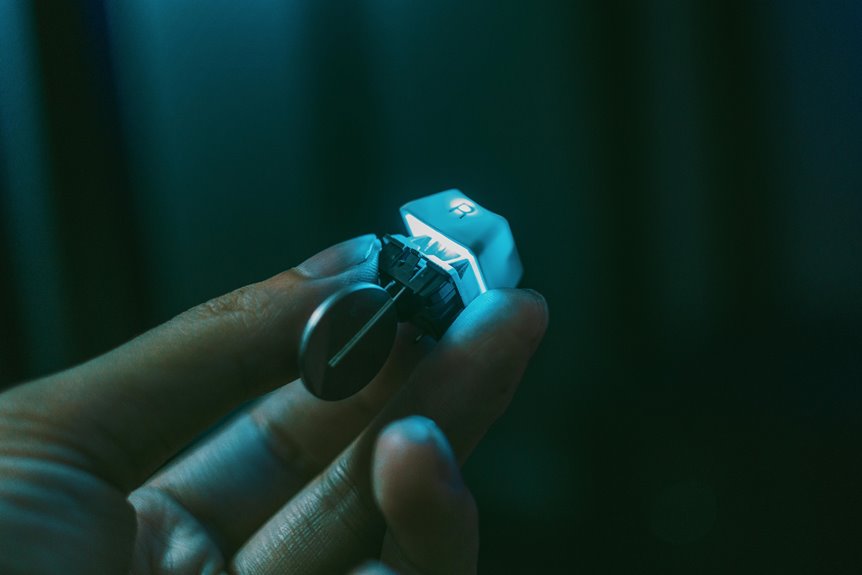If you're experiencing issues with your keyboard, it's essential to diagnose switch chatter effectively. You'll want to pinpoint erratic keystrokes that can disrupt your workflow. Start by observing your typing patterns and listening for any peculiar sounds. Identifying the problem can seem daunting, but with the right approach, you can tackle it systematically. Let's explore the symptoms and tools you'll need to uncover the root cause and restore your keyboard's performance.
Key Takeaways
- Check each key individually for unexpected repeated keystrokes during typing or testing sessions.
- Utilize key testing software to monitor keystrokes and identify problematic keys.
- Listen for unusual sounds like bounce or double-click when pressing keys.
- Observe typing patterns for erratic responses, including skipped or jumbled letters.
- Record findings to track affected keys, aiding in further troubleshooting or maintenance.
Understanding Keyboard Switch Chatter
Keyboard switch chatter can be a frustrating issue for anyone who relies on a mechanical keyboard. It occurs when a key registers multiple presses with a single stroke, leading to missed or duplicated inputs. This malfunction can disrupt your typing flow, causing you to lose focus or make errors in your work.
Understanding this issue is crucial for troubleshooting. Factors contributing to switch chatter include debris buildup, wear and tear on the switches, or even poor manufacturing quality. By identifying these causes, you can take appropriate steps to resolve the problem.
Regular maintenance, such as cleaning your keyboard and replacing faulty switches, can help you enjoy a smoother typing experience and reduce the chances of encountering switch chatter in the future.
Common Symptoms of Switch Chatter
How can you tell if your keyboard is experiencing switch chatter? Look for these common symptoms that indicate a problem:
- Repeated Characters: You type a single letter, but it appears multiple times on the screen, like "aaaaa" instead of just "a."
- Unresponsive Keys: Sometimes, you press a key, and it doesn't register at all, causing frustrating delays.
- Inconsistent Typing: Your keyboard may seem to randomly skip letters or insert them without you pressing the key, leading to jumbled text.
If you notice any of these issues, it's a strong sign that switch chatter might be affecting your keyboard.
Addressing it early can save you from further complications down the road.
Tools Required for Diagnosis
Diagnosing switch chatter effectively requires a few essential tools at your disposal. First, grab a reliable key tester, as it'll help you identify erratic key presses. Next, a multimeter can provide insights into the electrical signals emitted by your switches. Lastly, a software tool like a key logger lets you observe keystrokes in real time.
Here's a quick overview of these tools:
| Tool | Purpose | Notes |
|---|---|---|
| Key Tester | Identify erratic presses | Simple and user-friendly |
| Multimeter | Check electrical signals | Requires some technical skill |
| Key Logger | Observe keystrokes | Useful for software diagnosis |
With these tools, you'll be well-prepared to tackle switch chatter diagnosis effectively.
Step-by-Step Diagnosis Process
With your tools ready, it's time to start diagnosing switch chatter. Begin by checking each key individually. Press down on each switch and pay close attention to any unexpected repeated keystrokes. Use your testing software to monitor the output; it'll help pinpoint the problematic keys.
- Listen for any unusual sounds, like a slight bounce or double-click.
- Observe your typing patterns; note if certain keys respond erratically or inconsistently.
- Record your findings to track which keys are affected.
Once you've identified the keys that exhibit chatter, you'll have a clearer idea of where to focus your efforts. This methodical approach will guide you in determining the extent of the issue before considering solutions.
Solutions and Preventive Measures
To effectively tackle keyboard switch chatter, you should consider both immediate solutions and long-term preventive measures.
First, try cleaning your keyboard with compressed air to remove dust and debris that could be causing the issue. If that doesn't work, consider replacing the affected switches or the entire keyboard if chatter persists.
For long-term prevention, regularly clean your keyboard to keep it in good shape. Additionally, use a keyboard cover to protect against dust and spills.
Invest in high-quality switches known for durability and reliability. Finally, ensure your keyboard's firmware is up-to-date to avoid any software-related issues.
Frequently Asked Questions
Can Switch Chatter Affect Wireless Keyboards Differently Than Wired Ones?
Yes, switch chatter can affect wireless keyboards differently than wired ones. Wireless connections may experience more interference, leading to inconsistent inputs, while wired connections generally provide a stable signal, minimizing the chances of chatter impacting performance.
Are Certain Keyboard Brands More Prone to Switch Chatter?
Yes, certain keyboard brands are indeed more prone to switch chatter. You might find that budget models or those using lower-quality switches experience this issue more frequently than premium brands that prioritize build quality and reliability.
How Does Humidity Impact Keyboard Switch Performance?
Humidity can significantly affect your keyboard's performance. High humidity may cause key switches to become sticky, while low humidity can lead to brittleness. Keeping your keyboard in a controlled environment helps maintain its responsiveness and longevity.
Is Switch Chatter Covered Under Warranty Policies?
Switch chatter often isn't covered under warranty policies unless it results from manufacturer defects. You should check your specific warranty terms to see what issues are included. Keep your receipt handy for claims.
Can I Prevent Switch Chatter With Regular Maintenance?
Yes, you can prevent switch chatter with regular maintenance. Keeping your keyboard clean, avoiding debris buildup, and ensuring proper lubrication can significantly reduce the chances of chatter. Regular care keeps your keyboard functioning smoothly and reliably.
